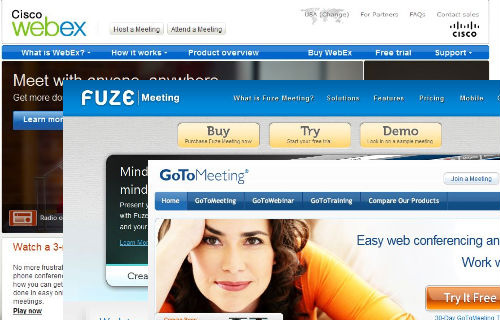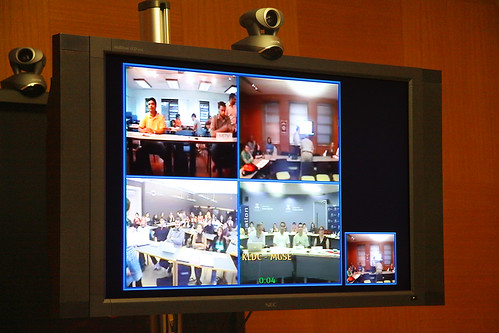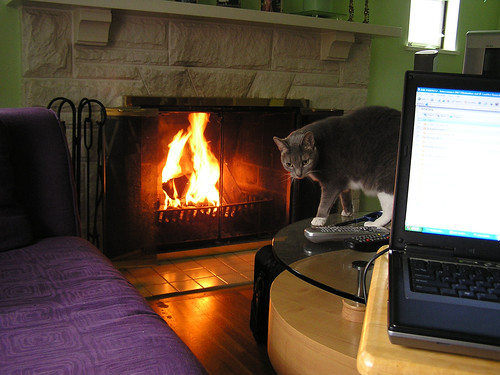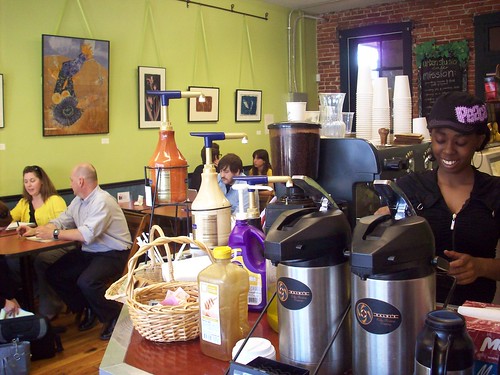What does the new economy mean for the shape of communities?

Posted February 6, 2012 at 1:28PM
About a year ago, several of us attended a meeting in Washington at which a prominent smart growth leader was showing a presentation on “the business case for smart growth.” Much of it was based on the need for everyday, face-to-face business communication within companies and the need for dense environments to facilitate efficient productivity and movement of goods. He stressed that this has always been the case, making connections to history and to studies reaching back for decades.
There was only one problem. Several meeting attendees were participating via conference call, following the presentation via their computers and internet connections in remote locations. They were virtually countering the speaker’s point as he was making it.
Indeed, a number of partners in the smart growth coalition we represented were, and are, advocating telecommuting as a way of saving transportation energy and infrastructure. The communications director for Transportation for America, a coalition whose staff is based in DC, works remotely from Seattle. An official at the US Patent and Trademark Office, which has an aggressive telecommuting program, reports that at a given moment up to a staggering 80 percent of agency employees might be working from remote locations. Heck, I have one colleague who worked for NRDC (in theory, as an employee of our San Francisco office) for five years seamlessly from Italy, for no other reason than she wanted to and was able to make it work. And so on.
Our speaker was making a 20th-century argument in a 21st-century economy.
And yet the 21st century is shaping up as a decidedly urban epoch, with downtowns more popular than they have been in 50 years and suburbs reshaping themselves in ever-more urban forms. What’s going on?
Thomas Fisher, dean of the College of Design at the University of Minnesota, believes that we are undergoing an enormous change in “how people will live and work, in how businesses will operate, and in what services and support we will need from government.” Writing in The Huffington Post, Fisher contends that the 20th-century model of large-scale, heavy industry is largely over and that the new workforce is much more independent and nimble:
“In the next economy, ‘manufacturing’ may more-often occur at a micro scale, with free-lancers 3D printing in their back bedroom or the self-employed laser-cutting products in their garage . . . Self-employed entrepreneurs rely upon durable, high-bandwidth infrastructure in order to communicate with and ship to customers globally. They need affordable health care equivalent to what large companies provide their employees. And they tend to congregate in places with a high quality of life, where other entrepreneurs go.”
So, yes, we still want to congregate, maybe more than we have in a long time, but for different reasons now.
Continuing, Fisher explains that the new economy demands changes in our built environment, to encourage adaptation of old buildings in new ways and to foster intermingled homes, workplaces, and shops:
“With the rise of the contingent workforce, people will also live and work in ways we haven't seen for a very long time. We have developed our cities based on the old economy, with residential, commercial, and industrial areas kept separate and ‘pure’ through single-use zoning. That made sense in an economy that divided our work lives from our private lives, and that spawned large-scale noxious industries that no one wanted nearby. The next economy, though, may look more like the way in which people lived and worked prior to the industrial revolution, in which home, office, and shop co-exist in some combination of physical and digital space. This may require rethinking our zoning laws to allow for a much finer-grain mix of uses and repurposing buildings designed for single functions that will have no tenants or buyers if they remain that way.”
With former mainstays of retail such as bookstores and music stores giving way to digital commerce - and workplaces getting smaller - we’ll still need urban neighborhoods, mainly for “what we can’t get any other way.” This will certainly include face-to-face conversation, not necessarily within businesses but for socializing and for impromptu encounters among entrepreneurs pursuing separate goals that are stimulated by new ideas. And we may need a new educational approach, too, that stresses creativity, since preparing students for an ordered world that is becoming less so every day could be doing them a disservice.
This, of course, leads directly to Richard Florida’s argument that we need cities more than ever, not to maximize efficiencies in the old order but in order to nourish the creativity that will be needed for success in the new. He elaborates in Business Insider:
“Our school system was designed in the Nineteenth century to socialize immigrants and provide them with the skills they needed to work on production lines. It is badly broken – a giant creativity-squelching machine—and must be retooled from the bottom up, no more tinkering at the margins. Our schools should stoke their students’ passions, unleash their talents, and nurture their creative and entrepreneurial potential . . .
“But the real key to unleashing our creativity lies in humanity’s greatest invention – the city. Cities are veritable magnetrons for creativity. Great thinkers, artists, and entrepreneurs—the Creative Class writ large – have always clustered and concentrated in cities. Deeper in our past the concentration of people in cities not only powered advances in agriculture, but led to the basic innovations in tool-making and the rudimentary arts that came to define civilization . . .
“Real cities have real neighborhoods. They are filled with the flexible old buildings that are ideal for incubating new ideas. They are made up of mixed use, pedestrian scale neighborhoods that literally push people out into the street, cafes and other third places, encouraging the serendipitous interactions, the constant combinations and recombinations that result in new ideas, new businesses and new industries.”
Last week I moderated a panel at the annual New Partners for Smart Growth conference, in San Diego this year. The speakers in my session included my friend and architect/planner David Dixon who, along with Kevin Ratner of the large development firm Forest City Enterprises, shared their story of why the prosperous but sprawling Columbus suburb of Dublin, Ohio, is trying to reshape its center into a much more urban form. Simply put, Dublin has several large, corporate employers who need a steady influx of creative new employees. While in a strictly business sense many of these young, new recruits probably could telecommute to perform the tasks their employers require, they simply don’t want to live and socialize in sprawl. In order to stay competitive – the most important goal of Dublin’s business leaders – the suburb must attract creative-class workers by offering more urban amenities and a much stronger sense of place.
So, in the end, our coalition speaker who was making the "business case for smart growth" was right that business needs urban densities, but perhaps not much longer for the traditional reasons he was citing. If the reasons matter - and Fisher, Florida, and the Dublin experience all suggest that they do - both city planners and companies will need to take note in order to ensure that they are prepared for them. Cities will still be cities, but education, retail, and workplaces may all need to change, along with government services and regulation. The companies and communities that figure this out first are likely to be the ones to succeed in the next economy. Likewise for urban advocates.
Move your cursor over the images for credit information.
Please also visit NRDC’s Sustainable Communities Video Channel.



